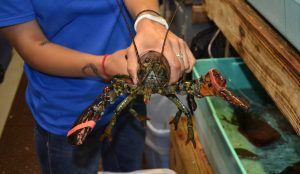Students’ Perspective on Investigating Species Diversity
 Marine organisms are found in every possible type of ocean habitat and environment. Throughout time — as marine organisms adapted to specific environmental niches — they specialized in virtually every way: including reproductive strategies, locomotion, feeding structures, and even entire life histories. After millions of years of competition and adaptation, we are left with an ocean environment that provides unparalleled species diversity, particularly in the invertebrate phyla. The SBS “Invertebrates of the Maine Coast” course is a great opportunity for students to explore — hands on — the amazing biodiversity of coastal marine species.
Marine organisms are found in every possible type of ocean habitat and environment. Throughout time — as marine organisms adapted to specific environmental niches — they specialized in virtually every way: including reproductive strategies, locomotion, feeding structures, and even entire life histories. After millions of years of competition and adaptation, we are left with an ocean environment that provides unparalleled species diversity, particularly in the invertebrate phyla. The SBS “Invertebrates of the Maine Coast” course is a great opportunity for students to explore — hands on — the amazing biodiversity of coastal marine species.
Investigating Species Diversity & Evolution
Students in the SBS “Biology of Marine Invertebrates” course explore the different phyla of marine invertebrates. Beginning with the phylum Porifera (or sponges), students are introduced to marine invertebrate phyla in order of increasing complexity. Students begin with the topic of germ layers, progress to the appearance of defensive and locomotory structures and, over time, investigate the increasing complexity of digestive systems and respiratory structures and systems. Eventually students learn about the appearance of “pseudo-vertebrates” and close relatives such as the Lancelet (Amphioxus). These highly complex invertebrates represent the predecessors to all vertebrates and are genetically related to us humans. Within this phylum “cephalochordata” species share almost all developmental features of chordates (e.g., post-anal tail, pharyngeal gill-slits, dorsal notochord etc.). However the brain is virtually absent consisting of a very basic nerve ganglia. As students progress through various phyla, they learn about the design, behavior and life history of diverse species. “It’s as if the appearance and implementation of vital biological structures happens right before your eyes,” from one SBS student’s perspective..
Hands-On Invertebrate Zoology
Throughout SBS, “Biology of Marine Invertebrates” each student collects and identify over 100 different local invertebrate species. This feat is achieved through extensive field work collecting organisms to bring back for identification. Locations of organism collection include local mud flats, other intertidal regions and subtidal through dredging of the marine benthos at many different locations using the “IRA C” research vessel. During the field missions organisms are found, collected and transported back to the Darling Marine Center (DMC). Upon arriving at the DMC, students identify the organisms using a dichotomous key for marine invertebrates of the northeastern United States coastal region. Many examples of the phyla not from the local region are also shown, thanks to the extensive specimen collection of professor and director Dr. Kevin Eckelbarger.
